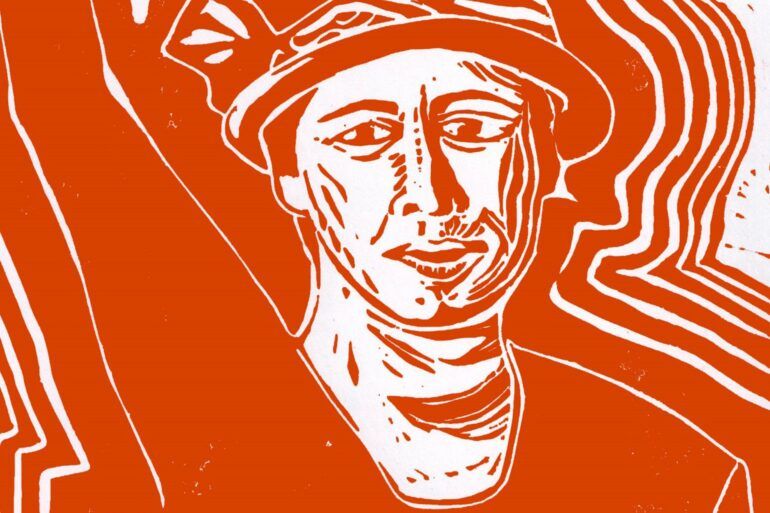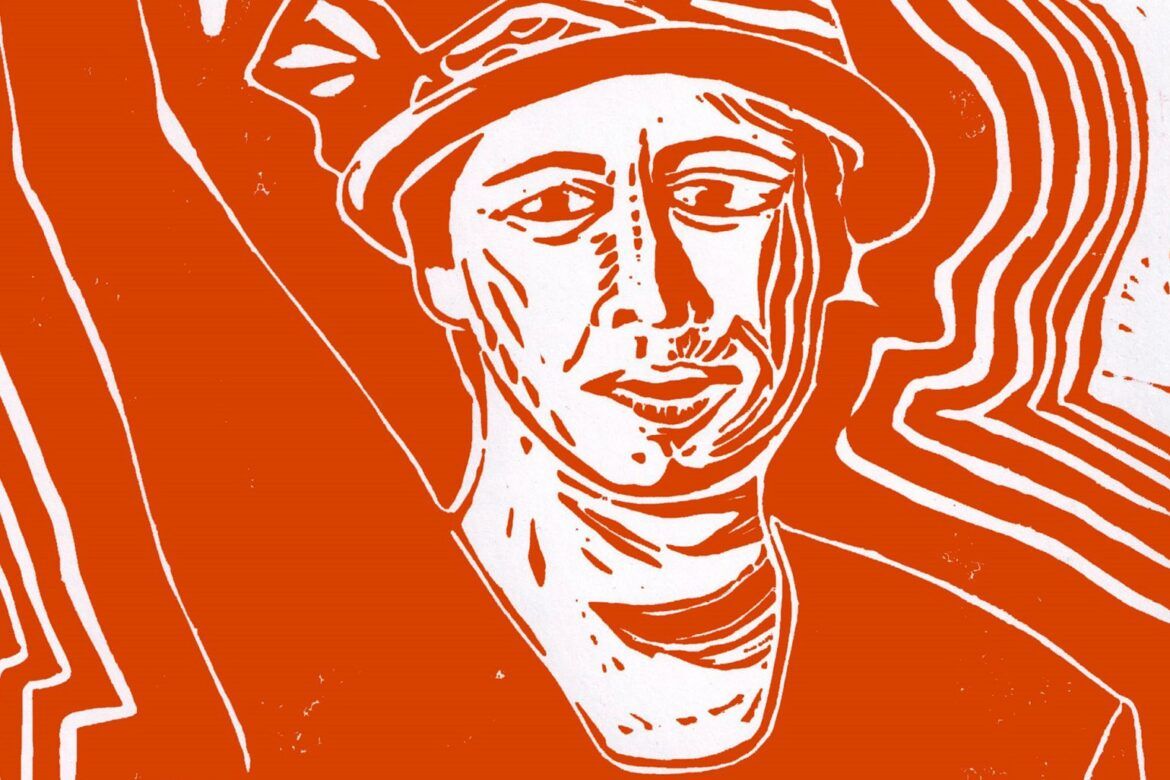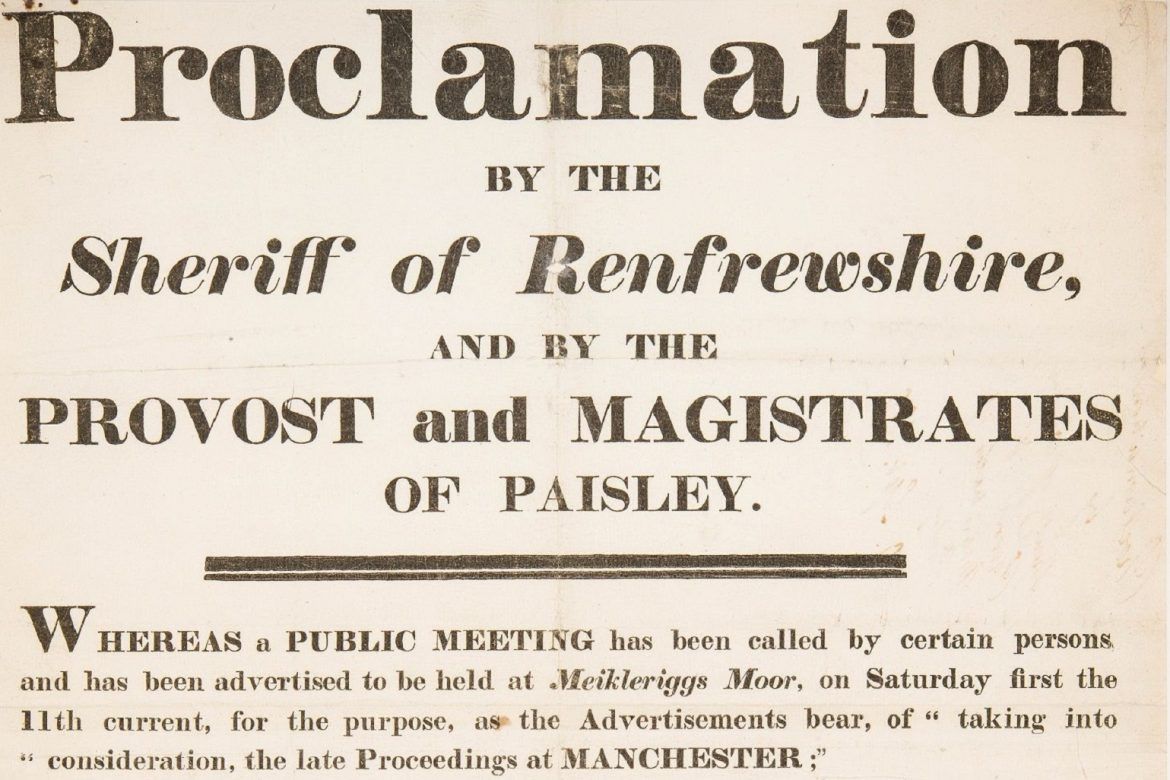Mary Barbour was born Mary Rough on 20th February 1875 at 37 New Street, Kilbarchan – the third of seven children to parents Jean Gavin and James Rough, a handloom carpet weaver.
In 1887, the family moved to Elderslie. Mary attended school until she was 12, before starting work as a thread twister and later became a carpet printer, as is the occupation recorded on her marriage certificate.
On 28 August 1896, Mary married David Barbour (1886-1957) – a journeyman specialising in iron turing – at Wallace Place, Elderslie. Sadly their first born son David died the year he was born in 1897, just one year after they were married. It is thought that he died of bacterial meningitis, which was a much more common cause of death prior to antibiotics being discovered as treatment in the 1940s.
Like many other working class families, the couple moved to Govan, close to the area’s massive shipbuilding industry. Here David began working at Fairfield Shipbuilder and Engineering Co Ltd. They settled in 5 MacLeod Street with their son James who was born in 1900. The 1911 census shows that they moved to 43 Ure Street where another they lived with their third son, William (born 1904). Finally in 1933 Mary Barbour moved to a council house at 34 Cromdale Street, Drumoyne, where she lived until she died.
Mary Barbour was a working-class mother with two sons, living in a period where women still had no right to a vote, so she understood first-hand the hardships that a working-class family in Govan could experience. She became an active member of Kinning Park Women’s Co-operative Guild, which was established in 1890, one of the first of its kind in Scotland. The aims of Women’s Cooperative Guilds were to enable women to discuss politics with one another, an area usually dominated by men. By 1923 there were around 300 Scottish Women’s Cooperative Guilds, providing support for women to enter the typically male sphere of local government.
Mary’s commitment to activism continued when she joined the Socialist Sunday Schools movement, teaching children and making them aware of the causes and consequences of poverty. She also became a member of the Independent Labour Party, earning her the label ‘Red Clydesider’ amongst contemporaries such as John Maclean and Helen Crawfurd. The labour movement was very active in campaigning on housing during this time, due to poor living conditions in working class areas in Glasgow. Mary’s organising and campaigning experience led to her playing a key role in forming and leading the South Govan Women’s Housing Association in June 1915.
During the First World War, housing in Glasgow became a major problem. Money grabbing landlords took advantage of women by attempting to force the rents up by approximately 8% over the course of the war, whilst most of the men were away fighting. At this time, women went to work in the munitions factories to contribute towards the war effort. This meant that women had to work longer hours to pay the increased rents, and if they were late in paying rent, their landlord threatened to evict them. At this time, Patrick, Govan and other inner city tenement areas were described as ‘congested’ which means they were overcrowded, were made worse in late 1914 by the influx of workers into munitions districts to staff factories for the war effort. Landlords took advantage of the situation and overcharged on the rents. This was profiteering and women in communities like Partick and Govan couldn’t afford it.
The Glasgow Women’s Housing Association (WHA) was born in 1914 in opposition to rent increases, a collaboration between the Glasgow Labour Party Housing committee and Mary Laird, president of the Women’s League. At the South Govan branch of the WHA Mary Barbour began actively organised tenant committees and eviction resistance, coming to the forefront of community activism and earning her status as the leader of ‘Mrs Barbour’s Army’. Her grassroots activism spread to ordinary housewives who had not had prior engagement in politics. Women found that by organising together, they could provide mutual and moral support for one another. In April 1915 the South Govan WHA led a protest against the eviction of a family in Govan, and this was followed by widespread physical resistance to rent increases.
Other leaders of the South Govan WHA included Agnes Dollan and Mary Jeff. The women together organised committees who met in secret in kitchens and closes, passing on news of evictions by handbells and rattles and printing notices to get the women together and drive off the Sheriff Officers. Can you imagine the racket?
Before they reached someone’s home to evict them, Sheriff’s Officers were met by an army of furious women, reportedly driving them back using ‘peasemeal, flour and whiting’. Across Govan there were notices pasted in windows reading ‘we are not removing’ and resistance soon spread to other parts of the city, so that by November 1915, 20,000 households were refusing to pay the rent increases, backed by the force of ‘Mrs Barbour’s Army’.
On 17 November 1915 a factor took eighteen tenants to court for refusing to pay increased rents. The women who had been organising against evictions were having none of it. The South Govan WHA marched with thousands of women through the streets of the city to the Glasgow Sheriff’s Court to protest against the court summoning. Shipyard and factory workers threatened to strike in support of the WHA, strengthening the ‘Rent Strike’. A crowd of over 4000, accompanied by a brass band, reportedly took over the court, shouting, banner waving and making as much noise as possible.
Agnes Dollan commented later that it was because many of the male occupants of households were away fighting in the war that the protestors gained such widespread support, united by the experience of both war and disgust at scrupulous landlords.
The ‘Rent Restriction Act 1915’ was quickly pushed through parliament after a resolution was passed unanimously by Glasgow City Council that rents should return to pre-war levels. This act gave working-class tenants throughout Britain greater protection against profiteering private landlords.
Mary Barbour’s political activism did not end after the success of the rent strikes. She also played a big part in the founding of the Women’s Peace Crusade (WPC) in Glasgow in 1917 along with friends and fellow activists Agnes Dollan and Helen Crawfurd. The WPC held street gatherings, distributed ‘anti-war leaflets’ and interfered with Glasgow Corporation meetings. Mary’s fight for peace continued following WW1; an advertisement in the Forward (10 June 1922) invites women to open air meetings of the Glasgow and West of Scotland Branch of the Women’s International League for Peace and Freedom, where both Councillors Agnes Dollan and Mary Barbour were speakers.
In 1920 Mary stood as a Labour candidate for the Fairfield ward in Govan and won with an overwhelming majority, serving for eleven years as the first woman councillor for Govan. During this time, she campaigned on numerous women’s and children’s healthcare issues including municipal banks, wash-houses, laundries and baths, a free milk supply for school children, child welfare centres and play areas, home helps and pensions for mothers. Mary also served on official committees regarding mortality in childbirth, and the provision of local child welfare clinics. Her own experience of losing her first son would have undoubtedly strengthened her commitment to these issues.
Mary was keen to make life easier for housewives, the primary occupation of women during this time. An article that she wrote for the Pioneer states:
“looking to the future, when housekeeping as we know it, with all the little utensils and wasteful methods of lighting and heating, washing and cooking, that at present make the house-mother little more than a household drudge, will be a thing of the past… The standard must be higher; better housing, and everything that makes life what it should be in the future must come first; the paying for it is the secondary consideration.”
Later in her career, Mary served as Glasgow Corporation’s first woman Baillie from 1924 to 1927 and was in this time appointed as a magistrate. She served on eight committees covering the provision of health and welfare services and was chairperson of the Women’s Welfare and Advisory Clinic, Glasgow’s first family planning centre, which opened in 1926 at 51 Govan Road. Despite birth control being controversial at the time, the clinic aimed to equip all married women with the education on how to limit their family size:
“We feel it to be of the utmost importance that this knowledge, which has long been in the hands of the rich, should be given to the poor also, for their benefit and well-being.”
Mary retired as a Councillor in 1931, however she still continued her activities on a range of housing, welfare and co-operative committees and in later years helped to set up and organise seaside outings for the children of disadvantaged families in Glasgow.
Mary died on 2nd April 1958 aged 83, a year after her husband David, at the Southern General Hospital. Her funeral was held at Craigton Crematorium near Govan.
On her death, Bailie Jack Davis wrote an obituary for the Govan Press in which he said:
“There are women in Govan today who think of Mrs Mary Barbour as one of the great leaders of the Labour Movement who truly represented its spirit and purpose, and I am inclined to agree with them. … Mrs Barbour has been out of the limelight of public affairs in this city for many years now but there never was a more revered and loved local leader than she was in the heyday of her active life.”
The rent strikes of 1915 signified a major victory for working class people, organised and won by women. This victory paved the way for a nationwide housing benefit system which was implemented after the Second World War and is still in use today.


